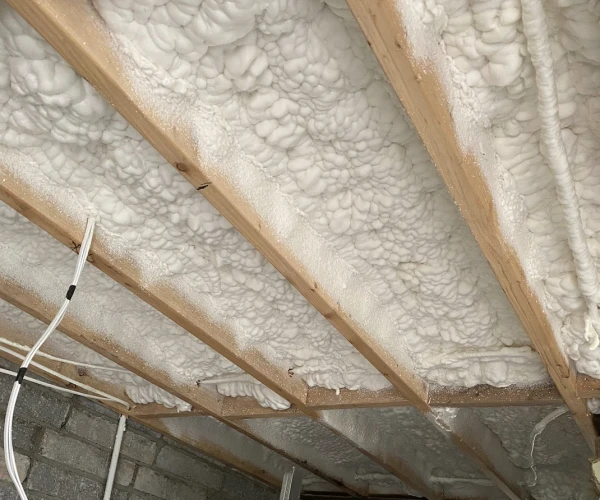
Why Choose Spray Foam Insulation for Autumn and Winter?
As the colder months approach, ensuring your home is well-insulated becomes a top priority. The changing seasons bring with them a drop in temperature, which can lead to increased energy bills if your home is not adequately prepared. One of the most effective solutions to keep your home warm and energy-efficient is spray foam insulation. In this guide, we will explore why spray foam insulation is the best choice for autumn and winter, how it compares to other insulation methods, and why it is the ideal solution for keeping the cold at bay.
What is Spray Foam Insulation?
Spray foam insulation is a type of insulation that is applied as a liquid and then expands into a solid foam. It is made from a combination of isocyanate and polyol resin, which react to create the foam. This insulation is known for its ability to expand up to 60 times its liquid volume, filling every nook and cranny in the space where it is applied. This unique property makes spray foam an excellent insulator, as it can create a complete seal, preventing air leakage and providing superior thermal resistance.
Types of Spray Foam Insulation
There are two main types of spray foam insulation: open-cell and closed-cell.
- Open-cell spray foam is lighter and less dense. It is ideal for interior walls and spaces where breathability is important. Although it provides good insulation, it is less effective at blocking moisture.
- Closed-cell spray foam is denser and more rigid. It offers higher insulation values and acts as a barrier against both air and moisture, making it suitable for both interior and exterior applications.
Why Choose Spray Foam Insulation for Autumn and Winter?
Superior Energy Efficiency
One of the primary reasons to choose spray foam insulation for the colder months is its superior energy efficiency. Homes with spray foam insulation typically experience a significant reduction in energy consumption, as the insulation creates an airtight seal. This means less warm air escapes during winter, and your heating system doesn’t have to work as hard to maintain a comfortable temperature. As a result, homeowners can save up to 40% or more on their energy bills, making spray foam insulation a cost-effective solution in the long run.
Enhanced Comfort and Warmth
Spray foam insulation is known for its ability to maintain consistent indoor temperatures. By preventing drafts and air leakage, it ensures that your home stays warm and comfortable throughout the colder months. Unlike other insulation methods, spray foam does not settle or degrade over time, which means its insulating properties remain effective for years. This consistent performance makes it an excellent choice for those looking to improve their home’s comfort during autumn and winter.
Moisture Resistance
Another critical advantage of spray foam insulation, particularly closed-cell foam, is its resistance to moisture. During autumn and winter, homes are more susceptible to moisture-related issues such as condensation and mould growth. Spray foam insulation acts as a barrier against moisture, preventing these problems from arising. This is especially important in areas like basements, crawl spaces, and attics, where moisture can easily accumulate.
Structural Integrity
In addition to its insulating properties, closed-cell spray foam insulation can also add structural strength to your home. When applied, it adheres to surfaces and hardens, providing additional support to walls, ceilings, and roofs. This added strength can be particularly beneficial in areas prone to heavy snowfall or strong winds, as it helps protect your home from the elements.
The Installation Process: What to Expect
Can You Install Spray Foam Insulation in Cold Weather?
One common concern about spray foam insulation is whether it can be installed during the colder months. While it’s true that colder temperatures can present challenges, modern spray foam products have been developed to perform well even in lower temperatures. Many professional installers use winter blends of spray foam that are specifically designed to be applied in colder conditions. These winter blends ensure that the foam cures properly and adheres to surfaces, even when outdoor temperatures are low.
Professional Installation vs DIY
While some home improvement projects are suitable for DIY, installing spray foam insulation is not typically one of them. The installation process requires specialised equipment and expertise to ensure the foam is applied correctly and safely. A professional installer will be able to assess your home, recommend the appropriate type of spray foam, and ensure that it is applied in a way that maximises its insulating properties. This is particularly important during autumn and winter when the colder temperatures can complicate the installation process.
For homeowners in Ireland, partnering with an experienced professional like Tamburah can make a significant difference. With a strong focus on energy efficiency and eco-friendly solutions, Tamburah provides comprehensive spray foam insulation services tailored to meet the unique needs of both residential and commercial properties. Our expertise ensures that each installation is performed to the highest standards, helping you achieve maximum energy savings and comfort during the colder months. Our commitment to quality and sustainability has made us a leader in the Irish insulation market, known for enhancing property value and long-term savings through effective insulation solutions.
Spray Foam Insulation vs Other Insulation Methods
Fibreglass Insulation
Fibreglass insulation is one of the most common types of insulation used in homes. It is relatively inexpensive and easy to install, making it a popular choice for many homeowners. However, it has several drawbacks compared to spray foam insulation. Fibreglass insulation does not create an airtight seal, which means air can still leak through, reducing its overall effectiveness. Additionally, fibreglass can absorb moisture, leading to potential mould growth and a decrease in its insulating properties over time.
Cellulose Insulation
Cellulose insulation is made from recycled paper products and is often treated with fire retardants and insect repellents. It is an eco-friendly option and provides good thermal resistance. However, like fibreglass, cellulose insulation does not provide an airtight seal. It can also settle over time, reducing its effectiveness. Moreover, cellulose insulation is susceptible to moisture, which can compromise its performance and lead to mould growth.
Spray Foam Insulation: The Superior Choice
When comparing spray foam insulation to fibreglass and cellulose, it becomes clear why spray foam is the superior choice, especially for autumn and winter. Its ability to create an airtight seal, resist moisture, and maintain its insulating properties over time make it the best option for keeping your home warm and energy-efficient during the colder months.
Best Ways to Insulate Windows for Winter
The Role of Windows in Home Insulation
Windows are one of the most significant sources of heat loss in a home. Even if your walls and roof are well-insulated, poorly insulated windows can allow warm air to escape, leading to higher energy bills and a less comfortable home. Insulating your windows is, therefore, a crucial part of preparing your home for winter.
Spray Foam Around Window Frames
One of the best ways to insulate windows for winter is to use spray foam around the window frames. When applied correctly, spray foam can fill the gaps and cracks around the window frame, preventing air leakage. This method is particularly effective when combined with other insulating measures, such as installing double-glazed windows or using thermal curtains.
Window Insulation Kits
Another option for insulating your windows is to use a window insulation kit. These kits typically include a plastic film that is applied to the interior of your windows and sealed with double-sided tape. The film creates an additional barrier against cold air, helping to reduce heat loss. While not as effective as spray foam insulation, window insulation kits are a budget-friendly option for improving your home’s energy efficiency.
Thermal Curtains and Window Coverings
Thermal curtains are another excellent way to improve your windows’ insulation. These curtains are made from thick, insulating materials that help block out cold air and keep warm air inside. When combined with other insulating methods, such as spray foam around window frames, thermal curtains can significantly reduce heat loss and improve your home’s comfort during winter.
Invest in Spray Foam Insulation for a Warmer, More Efficient Home
As autumn turns into winter, ensuring your home is well-insulated becomes essential. Spray foam insulation offers numerous benefits that make it the ideal choice for keeping your home warm, comfortable, and energy-efficient during the colder months. Its ability to create an airtight seal, resist moisture, and strengthen your home’s structure makes it superior to other insulation methods. Additionally, by insulating your windows with spray foam and other methods, you can further enhance your home’s energy efficiency and comfort.
If you’re looking for a long-lasting, effective solution to prepare your home for autumn and winter, spray foam insulation is the best choice. Whether you’re upgrading your current insulation or insulating a new home, investing in spray foam will pay off in the form of lower energy bills, a more comfortable living environment, and peace of mind knowing your home is well-protected against the elements.
